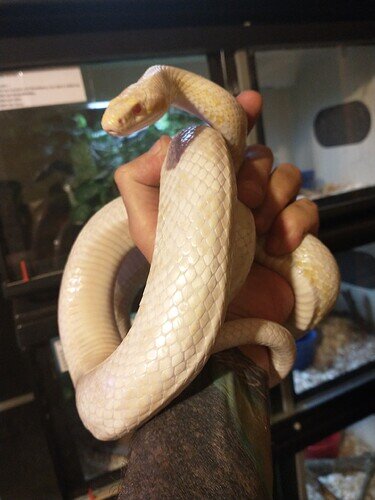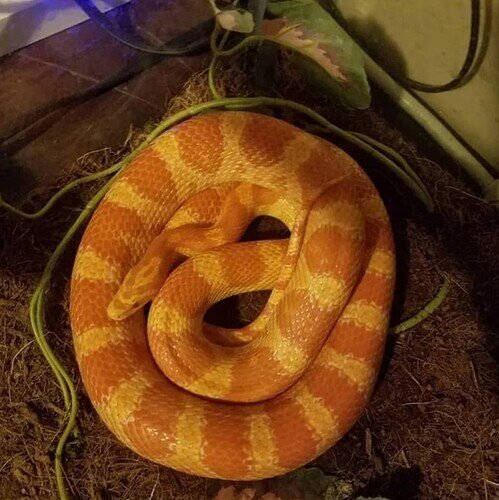I have my first ever clutch in the incubator and have the temp set at 79⁰. I can’t find a solid answer on what temp i should be keeping though. One place will say 78⁰ to 84⁰, and the next will say 79⁰ to 89⁰. Found a few that say an exact temp of 84⁰ or 86⁰. Anyone with experience that knows what is the best temp i would greatly appreciate the feedback.
If you’re talking about corns, the reason you see so much variation in recommended temps is because their eggs can tolerate a lot of variation! I personally just incubate at room temp (varies from probably 75 to 80 most of the time). I would recommend caution if you want to incubate at higher temps as too much heat can cause deformities or outright kill the eggs.
I always set my incubator to 84 I figured if it was off either way by a few degrees it wouldn’t matter. I hatched corn, king, and even some hybrid(junglecorn) eggs at this for multiple seasons no issues or deformities. Best of luck hatching your first clutch is always exciting!
Thanks. Should i increase the temp all at once or slowly warm it up?
I’ve got mine in an incubator with a thermostat tucked into the perlite. Set to kick on at 81.5ºF and off at 83ºF to give me a more consistent temperature around 82ºF.
I bumped it up to 81⁰ and will probably leave it there. I have a brand new exo terra incubator and also have a thermometer laying on top of the egg box that has consistently matched with the reading on the incubator so i’m pretty comfortable that my temps are consistent.
This is also my first clutch so I’m in the same boat you are, temps wise.
One thing I will suggest: It’s always good to have a redundant system just in case you have an incubator malfunction. A breeder I purchased from last year had a devastating incident where they lost everything in their incubator when it malfunctioned while out of town. For this reason I refuse to trust the thermostat on the incubator and have the whole thing hooked up to a thermostat control as well. It has an alarm to alert me if the temperatures inside go outside of the programmed range and turns the power to the outlet off if it gets too hot.
It’s frustrating to try and find THE answer when one is searching and trying so hard to do everything just right. The thing is, as Olivia said, sometimes THE answer doesn’t actually exist.
It makes sense. Birds’ eggs are more dependent upon steady and specific temps because they’re incubated by a “setting” adult. Corn snakes’ eggs (and those of many other species) are incubated by Mother Nature instead of a mother hen, so they must be tolerant of and safe at a range of temps. That’s a comforting thought, really.
I candled all of the eggs last night. Out of the original 30 eggs 23 are viable. The other 7 were slugs and removed from the trays. 2 more females set to lay in roughly 2 weeks but both are first year breeders so not expecting big clutches from either.
I’m curious, what morphs are these pairings? What are you hoping for?
The first 2 are Amelanistic and Anerythristic. 1 Snow Anerythristic male. Bread with a Anerythristic, Amelanistic female, and a Amelanistic male with a Normal, 100%het Anerythristic female. The next 2 coming up are a pair of reverse okeetee and a pair of Sunrise. The Okeetee pair are first year breeders and the Sunrise pair were bread last year and laid 6 eggs.
I’m a little confused here. What do you mean by “Snow Anerythristic?” Snow is a combination of homozygous for both Anerythrism and Amelanism. You say this male was bred to a female who’s “Anerythristic, Amelanistic.” So this pair is Snow X Snow?
I see you’ve also got a pair of Reverse Oketees. I really like those!
The male is solid white. He was listed as a snow when i purchased him, but under traits it says Anerythristic. The female is yellow and orange and was listed as both. Anerythristic and Amelanism. I’m not well educated on the morphs just yet lol. These are just adults that i picked up to get started with my breeding program to learn the ropes of breeding and hatching. My long term plan is to go with pure bloodlines like the okeetee and sunrise until i learn about all the morph possibilities before going down that road. I started this as a hobby/business opportunity for my 2 teenage sons. I just started last June and have acquired a total of 18 snakes so far, but most are juveniles right now. Besides the 18 corns i also have a trio of albino checkered and 4 Florida blue Garter snakes. Those are far more complicated to breed than the corns are. I have a lot to learn.
Do you have photos of the snakes you could share? Would make the genetic explanation clearer.
If your male is solid white and was advertised as Snow, then he’s both Anery and Amel. Perhaps the seller accidentally un-clicked Amel? Idk. If the female is yellow and orange, that sounds like an Amel morph. Have you got pics?
I went and looked up the ads from when i bought both of them. The male is listed as a Snow, Amelanistic, Anerythristic. The female is listed as Amelanistic only. These adults are my guinea pigs so to speak to learn the husbandry, brumation and breeding process, and incubation and hatching of the eggs while i wait on my more expensive juveniles to grow up. I’m trying to leave most of the learning of the genetics up to my boys as this is actually going to eventually be their hobby/business venture. 10 months ago when my boys came to me about doing this i didn’t know what a morph was lol.
He does look to be a Snow and she’s definitely an Amel, so that pairing will give you Amels het Anery, and if the female is het for Anery you should get some Snows
She only gave me 5 eggs. Very large healthy eggs but still only 5. I guess this was her first year being bread. I’m not looking for anything special this year other than the Okeetees and Sunrise pairs. Just experience with hatching and getting babies started feeding and the shipping process.
Also remember she will probably double clutch, even if the male is not introduced to her again. Mine rarely ever just laid a single clutch, so you may still get more eggs. Another tip, usually it is easy to see slugs, as they will get hard and yellow very fast. Be careful when you candle it is easy especially with small corn eggs to not see a lot of veins or think it is bad. If you ever have questionable eggs that you are in the fence about incubate anyway. Worst that will happen is they will go bad, remove them then. I don’t even bother to candle my bp eggs anymore, for the same reason.

